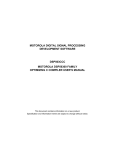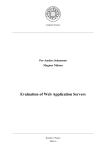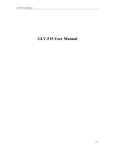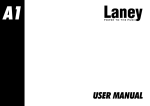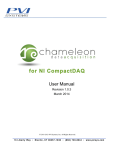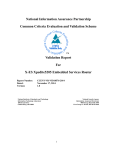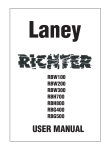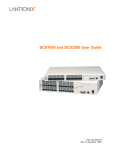Download Interface and programming guide
Transcript
SecurityLib 1.0
by
MarVic
Interface and programming
guide
Table of contents:
INTRODUCTION........................................................................................................................................................ 2
Who should read it? ................................................................................................................................................... 2
General information ................................................................................................................................................... 2
When TSecRights object is const? ............................................................................................................................. 2
__stdcall vs. __fastcall ............................................................................................................................................... 3
SYSTEM INTERFACE............................................................................................................................................... 3
What is it? .................................................................................................................................................................. 3
Security manipulating routines ................................................................................................................................... 3
Auto login password protection.................................................................................................................................. 5
System data common to whole application ................................................................................................................ 5
SECURITY INTERFACE........................................................................................................................................... 5
Logging in Security object ......................................................................................................................................... 6
Logging out ................................................................................................................................................................ 7
Showing administrator dialog..................................................................................................................................... 7
Showing user dialog ................................................................................................................................................... 7
Modifying user rights and parameters programmatically ........................................................................................... 7
OBJECT INTERFACE ............................................................................................................................................... 8
Constructors ............................................................................................................................................................... 8
User interface ............................................................................................................................................................. 8
Miscellaneous functions ............................................................................................................................................. 9
RIGHTS AND PARAMETERS INTERFACE.......................................................................................................... 9
Rights functions.......................................................................................................................................................... 9
Parameters functions ................................................................................................................................................ 10
ADDITIONAL TYPES, CLASSES AND FUNCTIONS......................................................................................... 11
PARAMETERS EDITOR INTERFACE ................................................................................................................. 11
Base and child parameters........................................................................................................................................ 12
Exports ..................................................................................................................................................................... 12
Autonames feature.................................................................................................................................................... 12
Key security feature.................................................................................................................................................. 12
interface.doc
SecurityLib Info
1/15
TSecSmpParamEd and TSecParamEd interface ..................................................................................................... 13
Using not child parameters and database parameters ............................................................................................... 13
DATABASE PARAMETERS EDITOR................................................................................................................... 13
PASSWORDS GUIDELINES ................................................................................................................................... 13
SecurityLib database passwords............................................................................................................................... 13
SecurityLib's passwords ........................................................................................................................................... 14
SECUREDFORM UNIT............................................................................................................................................ 14
DB PROVIDERS........................................................................................................................................................ 14
What is it? ................................................................................................................................................................ 14
Registry .................................................................................................................................................................... 14
Enclosed DB providers ............................................................................................................................................ 15
Documents................................................................................................................................................................ 15
OTHER ....................................................................................................................................................................... 15
Other documents: ..................................................................................................................................................... 15
Introduction
Who should read it?
Well, programmers who wish to use the library.
General information
Whole functionality of library is encapsulated in two classes: TSecRights and TSecParamEd.. The
first is used to perform standard tasks, as connecting to SecurityLib database or checking password, while
the latter contains functions useful during the execution of custom property editor. The header files for
those classes are, respectively, Rights.h (Rights.pas, Rights.bas) and SecParamEd.hpp (SecParamEd.pas).
The implementation of SecurityLib uses VCL (Borland's Delphi/C++Builder Visual Component
Library) dlls. The names depends on the version of the SecurityLib and VCL, which has to match. Both
SecurityLib dll file and VCL files names (VCLx.bpl and VCLDBx.bpl, x stands for 4 or 5 or later) end
with number determining the version.. You have to distribute them with your application. It is strongly
recommended that if your application uses VCL too, SecurityLib should use the same version as the
program. If not, you will unnecessarily enlarge your application size by shipping two copies of VCL. If
the correct version of SecurityLib is not available, contact me.
When using SecurityLib in C++ applications, you should add SecurityLibx.lib to your project to
perform static linking of dll functions. In other programming languages, the link is done dynamically.
The TSecRight objects is used as a connection between user and an object called Security, which
takes care of all tasks except for administrator windows.. This object is hidden (not accessible for user).
Many TSecRights objects can point to one Security object - so you can access your rights and parameters
from many places. In fact, TSecRights functions like a pointer, as it simply contains one.
When TSecRights object is const?
And because of that, when TSecRight is const, it means that Security object should remain
unchanged. So, for example, retrieving parameters, rights or reading properties like Logged can be done
on const object, but doing all other things modifies the Security object, so they are allowed only on nonconst TSecRight objects.
interface.doc
SecurityLib Info
2/15
__stdcall vs. __fastcall
There are two versions of TSecRights class. Methods of original one use Borland's fastcall calling
convention, while the TSecStdRights use stdcall convention for compatibility with other programming
languages. The definition of second class is stored in StdRights.h file.
System interface
What is it?
The system interface is part of TSecRights methods, which are static, and are used to manipulate
objects that are common to whole library, for example objects for accessing SecurityLib databases. Here
we have two major groups of routines.
Security manipulating routines
Introduction
These methods are used to add, delete and find objects called Security. Each Security object
corresponds to one SecurityLib database connection (in the future, Security objects may be represented as
TSecurity Delphi/C++Builder design and runtime components). Database can be accessed only through
these objects. They are created dynamically, and the list of currently allocated Securities is maintained.
Then, if you want to get rights and params information for user, you have to know the name of Security
object, which corresponds to your database.
Adding Securities
There are four methods in TSecRights class used to add Securities. Each of them will set different
properties of created object.
When you create Security, you have to choose type of so-called auto login. You choose from
following possibilities:
enum SecAutoLoginType {
altNone, // no auto logging, have to log manually
altFixedPasswd, // fixed password given at creation of Security
altSimplePasswd, // shows passwd dialog and asks only once for
password
altPasswdDlg, // shows passwd dialog and ask about password till
it’s entered correcty or users exits dialog without passwd
altCustom // allows to write custom login event handler
};
First seven parameters and last two ones is common to all of methods:
static TSecurity * __fastcall AddSecurity(const char *secname,
const char *alias, const char *dbprov, const char *dbend, void * data,
const char *secuser, const char *secencpswd, /*... ,*/ SecEncodeFnc
f=0, bool autolog = true);
Secname is the unique ID of this Security, and adding two objects with same name may result in
unexpected behavior of library. Alias should point to security database, but the form of it depends on the
type of DB Provider used. In case of BDE it is a BDE alias, in case ADO it is connection string.
DBProv it is a string which contains the name of DB Provider, as set in the registry. These names
can be found in documentation of particular providers. DBEng is a name of DB Engine to use by
provider. Sometimes one provider – dll file may expose many types of databases – they can be selected
here. For names refer to documentation of providers. Data is a void pointer that will be passed to
provider. Different providers can accept different values.
interface.doc
SecurityLib Info
3/15
Secuser and secencpasswd are User and Password parameters for logging into SecurityLib
database. Password may be encrypted, as it’s stored in memory whole time Security object exists, and
could possibly be stolen. However, the read-only password, which you are suppposed to pass, typically is
public (see Passwords Guidelines). Decryption routine is called every time password is needed. Default
password decryption routine just does nothing – that is returns the same string it got. More information
about decryption procedures in section Auto Login Password Protection later this chapter.
The second last parameter is quite obsolete – it’s pointer to SecurityLib user passwords encryption
function. Now it is advised to use standard encryption functions, because it is secure enough, and it lets
other programs to log into your SecurityLib database.
Autolog parameter indicates if Security object should maintain a counter of currently binded to it
TSecRights objects. If it's true, binding the first TSecRights object to this Security object, will invoke
AutoLogin function (only if it wasn't logged in already). Destroying (or unbinding) the last TSecRights
bound to that Security object will log out from security database.
All functions return pointer to TSecurity – which encapsulates Security object. You can’t
manipulate TSecurity objects directly – there is no definition for this class. Only possible way to affect
Security object is to use static methods of TSecRights.
And now each method is described:
AddSecurity(const char *secname, const char *alias, const char
*dbprov, const char *dbend, void * data, const char *secuser, const
char *secencpswd, SecEncodeFnc f=0, bool autolog = true);
This one sets altNone auto login mode.
AddSecurity(const char *secname, const char *alias, const char
*dbprov, const char *dbend, void * data, const char *secuser, const
char *secencpswd,const char *fullname, SecEncodeFnc f=0, bool autolog =
true);
This one sets altSimplePasswd login type. Fullname parameter will be displayed in password
dialog as Security database name (in order to let user know which password should he use).
AddSecurity(const char *secname, const char *alias, const char
*dbprov, const char *dbend, void * data, const char *secuser, const
char *secencpswd,const char *user, const char *pswd, SecEncodeFnc f=0,
bool autolog = true);
This one sets altFixedPasswd login mode. Parameters user and password are used in logging in
SecurityLib.
AddSecurity(const char *secname, const char *alias, const char
*dbprov, const char *dbend, void * data, const char *secuser, const
char *secencpswd,const char *error, const char *wrongpswd, const char
*t, const char *fullname, SecEncodeFnc f=0, bool autolog = true);
This one sets altPasswdDialog mode. Given error message is displayed, when connection to
SecuritLib database could not be established. Wrongpswd message is displayed, when password entered
in dialog was incorrect, and t is the title of that message.
AddSecurity(const char *secname, const char *alias, const char
*dbprov, const char *dbend, void * data, const char *secuser, const
char *secencpswd, SecOnLogin onlogin, void *autodata, bool autolog =
true);
This one sets altCustom mode. SecOnLogin type is defined as follows
typedef bool __stdcall (*SecOnLogin) (TSecurity *co, void *);
interface.doc
SecurityLib Info
4/15
Routine gets TSecurity pointer it is supposed to log on, and void pointer, which was parameter of
AddSecurity function and is intended for custom programmer use. It should return true if and only if
logging was successful
You can log in by calling AutoLogin method of TSecRights.
Obtaining Security by name
There is special routine, which simply gets Security object name as parameter and returns
TSecurity pointer:
static TSecurity * __fastcall FindSecurity(char *name);
Removing Security object
static TSecurity * __fastcall DeleteSecurity(char *name);
I think it’s clear what it does and how to use it.
Auto login password protection
Because SecurityLib database password given while creation of Security object is stored as its
property, it has to be encrypted to provide maximum security. Password will be decoded each time user
tries to log in.
typedef char * __stdcall (*SecDecodeFnc)(const char *enc, char
*dec);
Function gets encrypted password and buffer for decrypted password as a parameters. After
decoding password, you should return it.
static void __fastcall SetPasswdDecoder (SecDecodeFnc co );
Above function sets decrypts function for all Security objects. It’s common for all objects, because
it real password is independent of it’s encrypted form, and you can use one function for decrypting all
SecurityLib database’s passwords.
This is older part of code, SecurityLib's database read-only password no longer has to be secret
(unless you want not-encrypted SecurityLib data to be secret) because only SecurityLib knows how to
obtain read-write password.
System data common to whole application
In this group there are functions, which sets properties influencing whole SecurityLib.
static void __fastcall SetAppHWnd(HWND app);
Call it as soon as the application main window handle is available. This is used to integrate
SecurityLib modal windows and message boxes with your application.
static void __fastcall SetMDIClient(HWND app);
This is thought to set the MDI client area of the main window, when you want the Security
Administrator and other windows to behave as MDI child windows. Currently not available.
static HWND __fastcall GetMDIClient();
Returns the handle of MDI client area.
Security interface
Here are routines which operate on Security objects created using functions described in previous
chapter.
interface.doc
SecurityLib Info
5/15
There are two groups of functions in this chapter. One group contains only static methods and
needs Security object to be explicitly specified while the second uses Security object attached to
TSecRights object.
Logging in Security object
This is very first thing you do after adding a Security (if you did not turned on the Autolog
function). You can choose between manual and automatic logging.
Automatic logging
If all needed data are stored in Security object, all you have to do is call AutoLogin function.
bool __fastcall AutoLogin();
static bool __fastcall AutoLogin(TSecurity *);
You can call this function before or after showing your main window or when you need to access
the rights.
Manual logging
This case is much more complicated, because you have to remember about preparing and
unpreparing logging.
static bool __fastcall PrepareLogin(TSecurity *s);
bool __fastcall PrepareLogin();
Above function prepares Security object for logging in, including connecting to database, checking
its signature and allocating some memory. It has to be called before any login function. Returns true on
success and false on failure.
static bool __fastcall PrepareLoginWindow(TSecurity *s,char
*fullname);
bool __fastcall PrepareLoginWindow(char *fullname);
This one prepares standard password dialog box. It calls also PrepareLogin. Fullname will be
displayed in dialog as Security database name.
bool __fastcall Login(SecAutoLoginType t);
static bool __fastcall Login(TSecurity *, SecAutoLoginType t);
It forces autologin of specified type. Currently useless, reserved for future use. Returns true if login
was successful.
bool __fastcall Login();
static bool __fastcall Login(TSecurity *);
Displays password dialog. Returns true if OK button was clicked, otherwise false.
bool __fastcall Login(const char *name,const char *passwd);
static bool __fastcall Login(TSecurity *, const char *name,const
char *passwd);
Tries to log in with specified user name and password to Security object. Returns true on success.
bool __fastcall Login(const char *error,const char *wrongpswd,
const char *t, const char *fullname);
static bool __fastcall Login(TSecurity *, const char *error,const
char *wrongpswd, const char *t, const char *fullname);
Displays password dialog until user enters correct user name and password or clicks cancel. If
password was correct, function logs in. Returns true if logged into Security object. Parameters have same
meaning as in AddSecurity function.
NOTE: This functions executes the PrepareLoginWindow().at the beginning and PostLogin before
exiting, so you don't have to care about it.
interface.doc
SecurityLib Info
6/15
static void __fastcall PostLogin(TSecurity *s);
void __fastcall PostLogin();
This should be called after unsuccessful login; technically after succesful call to PrepareLogin or
PrepareLoginWindow. It releases memory allocated for logging in. When the user has succefully logged
in, you don't have to call this function (it's called internally), but it is allowed and has no negative
consequences (including time penalties).
Logging out
It’s much simpler. Just call following routine:
void __fastcall Logout();
static void __fastcall Logout(Tsecurity *);
If you are not sure if user is logged into Security object, call
bool __fastcall Logged();
static bool __fastcall Logged(Tsecurity *);
which returns true if someone is logged in this object.
Showing administrator dialog
void __fastcall ShowDlg(HWND app, SecDBEditEncodeFnc fnc = 0);
static void __fastcall ShowDlg(TSecurity *co, HWND app, bool
mdichild, SecDBEditEncodeFnc fnc = 0);
It shows modal Security Administrator dialog. App parameter is handle of parent window – it is
used to integrate with your application. Mdichild parameter determines if dialog should be showed as
MDI interface child window. Fnc is used for encrypting password of Database Parameters Editor, which
is dialog box provided for you to easily store user name and password for your program database (when it
uses one).
typedef SecString __stdcall (*SecDBEditEncodeFnc)(const char *co,
int paramkey, int userkey);
It gets string to encrypt, and two keys, which should be used to encrypt data (that is, output string
should vary on that values) to ensure maximum security of your password. It should return encrypted
password.
Showing user dialog
void __fastcall ShowSmpDlg(SecDBEditEncodeFnc fnc = 0, bool
mdichild =false);
static void __fastcall ShowSmpDlg(TSecurity *, SecDBEditEncodeFnc
fnc = 0, bool mdichild =false);
This function is similar to the previous one, except it shows user dialog, which enables to view
rights and modify parameters only of currently logged user.
Modifying user rights and parameters programmatically
SecurityLib enables you to manipulate users programmatically, for example to create your own
user manager. This is done using the parameters editor interface.
TSecParamEd *__fastcall ModifyStart(const PswdString &key);
void __fastcall ModifyEnd(TSecParamEd *co);
Calling ModifyStart will open Security database in write mode, and return a pointer to editor
interface. More info on using the interface in the chapter Parameters editor interface.
The use of this function is restricted. You have to know the key to make use of this function. If you
want to use it, contact me, and I will give you the key.
interface.doc
SecurityLib Info
7/15
Object interface
In this part there are functions which operate on Security objects, but have no static versions. There
are though to be used with TSecRights object, which stores the reference to Security object. As they are
small and there are many of them, I think it would be not comfortable to use them passing Tsecurity * as a
parameter. So if you are going to make many operations on Security object, you should create TecRights
variable.
Constructors
__fastcall TSecRights() {}
Default constructor. Does nothing.
__fastcall TSecRights(TSecurity *co);
Creates TSecRights object and binds it to the given Security object. If the Autolog mode for
Security is on and the Security was not logged into Security database, it tries to log in. In case of failure,
throws ESecAutoLoginFailed expetion.
__fastcall TSecRights(const char *name);
Creates TSecRights object and binds it to the Security object which name was given. If it was not
found, Binded function returns false. If the Autolog mode for Security is on and the Security was not
logged into Security database, it tries to log in. In case of failure, throws ESecAutoLoginFailed exception.
__fastcall TSecRights(const TSecRights &co);
Copy constructor. Binds new TSecRights object to the same Security the given one was. Also
active right is copied.
User interface
SecString __fastcall UserName() const;
Returns the name of logged user in the Security object pointed by this TSecRights object.
FullString __fastcall UserFullName() const;
Returns the full name of logged user in the Security object pointed by this TSecRights object.
PswdString __fastcall UserPasswd() const;
Returns the encrypted password of logged user in the Security object pointed by this TSecRights
object.
int __fastcall UserID() const;
Returns the unique ID of logged user in the Security object pointed by this TSecRights object.
int __fastcall GroupID() const;
Returns the unique ID of logged user group in the Security object pointed by this TSecRights
object.
SecPasswdOption
SecPasswdOption
SecPasswdOption
SecPasswdOption
SecPasswdOption
__fastcall
__fastcall
__fastcall
__fastcall
__fastcall
UserAllowChangePswd()
UserAllowNullPasswd()
UserNoChPswdAtLogin()
UserAccountEnabled()
UserPasswdControl()
const;
const;
const;
const;
const;
These five functions return each password option. The possible return values are:
enum SecPasswdOption {
interface.doc
SecurityLib Info
8/15
poFalse,
poTrue,
poGroup
// user has that right
// user has not that right
// right of user is the same as group
};
The password option names are changed to reflect the return value: sometimes it’s a negation of option
showed in the change password box. This is because I wanted those values to be true only if it gives some
right or privilege to the user. In the following table there are the same options with both names:
Function name
Negated
Name
PasswdControl
No
Password Control
NoChPswdAtLogin
Yes
Change password at login
AllowNullPasswd
Yes
Disallow null password
AllowChangePswd
No
Allow changing password
AccountEnabled
Yes
Account disabled
bool __fastcall GroupAllowChangePswd() const;
bool __fastcall GroupAllowNullPasswd() const;
bool __fastcall GroupNoChPswdAtLogin() const;
bool __fastcall GroupAccountEnabled () const;
bool __fastcall GroupPasswdControl () const;
These five functions return the group password options. They're returning bool, as option for
groups can have only two states: granted or denied.
bool __fastcall GroupForceAddMod() const;
This function returns the force add to above groups right. When is true, when adding new group all
groups that are above the creator's group are set to be above the new group.
bool __fastcall GetAllowChangePswd() const;
bool __fastcall GetAllowNullPasswd() const;
bool __fastcall GetNoChPswdAtLogin() const;
bool __fastcall GetAccountEnabled() const;
bool __fastcall GetPasswdControl() const;
Those functions combine previous User... and Group... ones. They return effective state of the
option: if the value of user option is poGroup, they return Group... function value; else they just return
User... function value.
Miscellaneous functions
bool __fastcall Binded() const;
Returns true if TSecRights object has any Security object associated.
Rights and parameters interface
Functions in this interface enable you to work with rights and parameters values. You will use
those functions when you want to obtain those values i.e. to protect your windows or print a form.
Parameters are maximum 16 chars long.
Rights functions
int __fastcall GetRight(const char *name) const;
interface.doc
SecurityLib Info
9/15
Function retrieves right, which name matches parameter, from Security database, and puts its value
to the Rights data member. Returns unique ID of right. If there is no right with such a name function
returns –1 and set Rights to 0 – all basic rights not granted.
int __fastcall GetRight(int FormID) const;
Function returns right with identification number FormID. Identification number may be obtained
from previous calls to GetRight(const char *).
This function was thought to eliminate unnecessary searches against list of rights, but there won’t
be big penalty of speed, if you call the name version.
enum SecRightsMask { rmView=1, rmInsert=2, rmModify=4, rmDelete=8
};
union {
mutable SecRightsMask Rights;
struct {
mutable bool View :1;
mutable bool Insert:1;
mutable bool Modify:1;
mutable bool Delete:1;
};
};
This public data member is used to read right first retrieved by GetRight functions. You can use
Rights member to pass rights as parameters or perform bit wise operations. Reference View, Insert,
Modify and Delete members to get the appropriate basic right value.
operator SecRightsMask&() const { return Rights; }
This self-explanatory operator returns the Rights data member value.
Parameters functions
SecString __fastcall GetParam(const char *name) const;
SecString __fastcall GetParam(int ParamID) const;
Those two functions return a value of parameter as SecString. The parameter may be passed by
name or by ID, which currently cannot be obtain from any function. If there is no parameter with
specified name/ID, the functions return empty string. Can be used for any type of parameter.
PswdString __fastcall GetPswdParam(const char *name) const;
PswdString __fastcall GetPswdParam(int ParamID) const;
Functions return a value of specified parameter as a PswdString. There is no processing done
during the process of writing data to the database, particularly no transliterations, and it is meant to
operate on encrypted strings. Returns empty string when no parameter could be found.
NOTE: some database systems do not store data after the terminating NULL. It is not guaranteed,
that chars after NULL will be the same as those that were stored. It depends on your DB Provider.
bool
__fastcall GetBoolParam(const char *name) const;
bool
__fastcall GetBoolParam(int ParamID) const;
Return true only if the value of passed parameter name/ID is equal to the YesString defined in
database. Can be used for any type of parameter. If functions could not find parameter, return false.
int
__fastcall GetIntParam(const char *name) const;
int
__fastcall GetIntParam(int ParamID) const;
Return the value of passed parameter after converting it to the integer. If the value was not an
integer, or parameter could not be found, returns INT_MIN.
SecString __fastcall GetDBParam(const char *name) const;
bool
__fastcall GetBoolDBParam(const char *name) const;
interface.doc
SecurityLib Info
10/15
PswdString __fastcall GetPswdDBParam(const char *name) const;
Functions return the value of Security database parameter, which name was passed as an argument.
If there was no parameter with such a name, return empty string, false, or INT_MIN.
NOTE: some database systems do not store data after the terminating NULL. It is not guaranted,
that chars after NULL will be the same as those that were stored. This is handled in SecurityLib
functions, which need passwords.
Additional types, classes and functions
class ESecExcept: public exception {};
Defines base exception for all exceptions thrown by library.
Unfortunately, library cannot guarantee all exceptions thrown while executing library functions
will derive from this class. As library uses VCL, and those functions can also throw its own exceptions,
embracing all functions in try .. catch block to converting exceptions to another ones would be very
expensive. Therefore I decided not to do this. I think those exceptions will be thrown only in few cases,
i.e. when someone corrupted database file during execution of program, and you can catch them anyway
(esp. when using VCL).
class EDBProviderError: public ESecExcept {};
This exception class is thrown when there was a database provider error.
class EDBProviderDModError: public EDBProviderError {};
The exception is thrown when there was an error connected with database provider.
class EsecAutoLoginFailed: public EsecExcept {};
Thrown when the AutoLogin function was called by Bind() or TSecRights constructor, and the user
could not login into SecurityLib or during execution of PrepareLogin there was an error.
#define ParamValLen 16
#define FullNameLen 50
typedef smallstr<ParamValLen> SecString;
typedef smallstr<FullNameLen> FullString;
typedef pswdsstr<ParamValLen> PswdString;
This defines three string types used in library. The first one is used in all functions returning
parameter values as text. The second one is longer and used only for full names, and finally, PswdString
is used to operate on key and passwords, it preserves chars even after terminating null.
The smallstr<T> and pswdsstr<T> types are defined in strings.hpp header file. The implementation
uses static char types (arrays with fixed size), so no new/delete operations are needed. (if SecurityLib
returned the dynamically allocated string, it could not be freed in a normal way, but it would have to be
returned to library for destruction).
class TSecurity;
This is declaration of TSecurity data type. This release of SecurityLib does not include the
definition of the class.
Parameters editor interface
This interface is meant for custom parameter editors., that is, small dialog boxes, presenting the
information from standard parameters it their own form. With SecurityLib is shipped one example of
editor, called User Data Editor along with source code (Borland C++Builder 4/5). You can view it to
learn how to write your own one.
interface.doc
SecurityLib Info
11/15
In this chapter only the most important things will be discussed, as usually your editor will differ
from example one only in the number and names of children parameters. Usually, the editors are used to
present values of standard parameters in more convenient and friendly way.
Base and child parameters
Each custom parameter, when added into Parameter list, is seen by system as the parameter of
Default type (although its type name is different). That means that always under the name of that custom
parameter is a value, that you can get using standard functions. Also that value can be changed by user
without invoking the editor You can store additional data in child parameters (subparams) of other types.
Those parameters are strictly connected to your one: when your parameter is renamed, the child ones are
also. The same thing with removal.
Exports
The library should export four basic functions:
SecString _export __stdcall ShowUserEditor(const TSecSmpParamEd &co,
bool &cancel);
bool _export __stdcall InsertNewParam(const TSecParamEd &co);
bool _export __stdcall IterateThroughChildren(const TSecParamEd &co);
bool _export __stdcall RenameParam(const TSecParamEd &co);
Each of them gets as a parameter TSecParamEd interface. Using its functions, you should respond
to the call.
The first function is called, when user clicks the button with three dots in Parameters Values list. It
should show your custom window. After interacting with the user, it should indicate, if the user wanted
to apply changes, or discard them. You should return new value for base parameter (if it is needed).
The second routine will be called when user inserts new parameter of that type. The base parameter
is already inserted. You may display information window, ask for some options considering parameter
settings. Return true on success.
The iterate function is used to delete all parameters or perform oter task on all of child parameters.
You are supposed to call a function passed on all of your parameters. Return true if all function calls
returned true.
The last one should rename all subparams and return true if successful.
The function can have any names as they have to be entered in Parameter Types dialog. The
parameter editor library is unloaded after each use of one of the functions.
Autonames feature
To ease the necessity to enter the names of functions in the Parameter Types dialog box, they can
be filled automatically (see Admin's Manual). To do that, you have to export one more function:
void __stdcall _export _MarSecurityGetFunctionNames(TSecFncNames *co,
HWND app);
It has to have exactly that name. In this function you should set the TSecFncNames object members
to appropriate values. Also you should show some information about the editor to enable user to
recognize the library.
Key security feature
When using autonames, you can also pass name of so called key function and a encrypted key. This
is to prevent hackers from changing the dll file of editor. The key, encrypted for the first time now, will
interface.doc
SecurityLib Info
12/15
be saved in a once more encrypted form in database. Then, it will be always checked if the function
encrypts the key in the same way.
You have to protect your encrypt method and source with that code, because if you loose it, there
will be no other way that changing all copies of your editor file for one with new method.
TSecSmpParamEd and TSecParamEd interface
Most part of that interface should be clear, so I will wrote only couple of words.
There are two interfaces, because when only showing editor, there may be no capability to add or
remove parameters as it can be called from User Security window. So, using TSecSmpParamEd you
cannot access some of functions.
The …Sub… versions of GetParam, AddParam and all other functions does the same thing what
the usual routine except for it prepends the name you specified as a parameter with base parameter name.
This is just the simpler way to access child parameters.
The Def… functions reverts right's or parameter's value to group's default one.
Using not child parameters and database parameters
You may want to add a parameter with a unique name, which won't be renamed, and it will be
common to all of parameters of this type or even across different parameter types. You have to remember
to remove it after last of your parameters was deleted.
You can also access DB parameters and change theirs value. This may be the way to communicate
between parameters of different users.
Database Parameters Editor
It is built-in property editor. It is thought to be used to store user's account to log in to the main
program database - in case not all users have separate account in that database. You may create accounts
only for groups, and then use that parameter value to log in.
The password is stored in encrypted form as a separate parameter. You have to provide the
encrypting function. If you write it correctly - the output should vary on both keys - neither copying the
value from other user nor entering it manually in Show Hidden mode will enable hacker to get
unauthorized access.
Passwords Guidelines
This chapter covers the topics of various passwords in the system.
SecurityLib database passwords
You should get your SecurityLib database with DB Provider. Also, you should know how to
change the passwords. In that database there should be at least three accounts created.
Read-only account
This account is used at the begging by Securty object when preparing login. The password may be
public, unless you want the information about user rights and parameters to be secret. All substantial
internal data is encrypted, so you don't have to worry about someone stealing full access.
Read-write account
interface.doc
SecurityLib Info
13/15
This one is used by User Administrator. SecurityLib needs full access to all it's tables and queries.
The password is stored in SecurityLib database (of course encrypted). To set it, there is a special utility
included in the package, called PasswdSetter. You should enter there connection data (as a database
account use Administrator's account) and password. Using this program you can also register the
database. This password is not public.
Administrator's account
There should be one with full access, and possibility to change other's account passwords. When
you get the database with DB Provider, it should be empty, but you have to change it before distribution.
You may want to give away the password to your customers - sometimes (for example if SecurityLib's
Admin forgets his password) there is no other way that manually modifying the passwords of users - you
can it to be empty. This password is also strictly confidential. It is the best if each customer has different
passwords.
SecurityLib's passwords
These are stored in database in encrypted form. You should not modify it without using
SecurityLib. The only reason may be forgotten password. In that case you should delete all chars from
Password field of Users table.
SecuredForm unit
This is the unit, which is intended to simplify the use of library. With it, you do not have to worry
about creating TSecRights objects, initializing it or anything at all (although it is necessary to create a
Security object with call to AddSecurity function). All you have to do is derive your form from this class
(it is a good idea to put the SecuredForm into object repository, and then use inherit option to create new
forms), and in the constructor of new form call constructor of SecuredForm with second parameter
denoting the SecurityLib object (by name). The right that has the same name like the new form will
automatically read during construcion.
Then you can use several methods to set appriopriate properties of the controls corresponding to
the read rights. You can assign a function to the OnRightsRead event that will be called after rights have
been read successfully. Also you can override virtual function RightsRead, which originally fires
OnRightsRead event. Still, you may use Rights object in any place in your code – so you might just set
the properties in the constructor of the new class.
After construction you may use two additional methods: Bind – that rebinds the Rights object to
another Security object and ReadRights, which rereads rights from database and calls RightsRead.
DB Providers
What is it?
DB Providers are dll libraries that take care of connecting to the security database and retrieving
data. One DB Provider may consist from many files and it can support many kinds of database
connectivity. There is a list of DB Providers maintained in system registry. There may be many versions
of one provider, each for different version of VCL. That version must match that of main SecurityLib file.
Registry
Names
and
paths
of
DB
Providers
are
stored
in
registry
in
HKEY_LOCAL_MACHINE\SOFTWARE\MarVic\SecurityLib\DBProviders key. Each value name in
this key corresponds to DB Provider name, and the value is interpreted as path to the DB Provider file.
You may also omit path, then standard windows search procedure for dlls will be used.
interface.doc
SecurityLib Info
14/15
It is recommended that names of DB Providers should be of following form:
Vendor:DBSystem:VclX, where Vendor is short name of the company that produced the DB providers,
DBSystem should denote the type of databases that the provider will use, and X corresponds to version of
VCL.
Currently four names are used: MarVic:ADO:Vcl5, MarVic:ADO:Vcl4, MarVic:BDE:Vcl5,
MarVic:BDE:Vcl4.
The setup program of your application should write the name and path of db provider into registry.
It also should chech whether there are no newer versions of shipped db provider already existing in the
system.
Enclosed DB providers
Currently two DB Providers are available. The first one is for Borland Database Engine, which
uses standard C++Builder components, and the second uses ADO, and is based on ADO Express
components. There are two versions of BDE provider: for VCL 4 and for VCL 5. BDE Provider in VCL 4
version needs no additional libraries (all code is in vcldb40.bpl), and version for VCL 5 needs
vclbde50.bpl library. ADO provider uses vclado50.bpl. You must ship these files with your application.
Documents
There are additional documents describing DB providers:
“Custom database access”
How to create new DB provider
“BDE Provider”
Description of BDE DB provider
“ADO Provider”
Description of ADO DB provider
Help files
The default location for help files is in Windows Help directory in subdir SecurityLib. But, this can
be overridden by registry settings. The new path should be placed in key
HKEY_LOCAL_MACHINE\SOFTWARE\MarVic\SecurityLib\1.0\HelpFilesLocation of type string.
Other
Other documents:
“SecurityLib info”
Basic information and introduction.
“User’s Manual”
Information for users of programs based on SecurityLib.
“SecurityLib Administrator Manual”
Information for administrators.
“Interface and programming guide”
Information for programmers.
www.marvic.prv.pl/securitylib/
SecurityLib website.
MS Access, Windows are trademarks of Microsoft Corp.
All other trademarks are owned by their respective owners and were used only in information purposes.
interface.doc
SecurityLib Info
15/15















